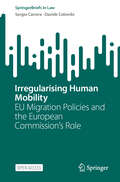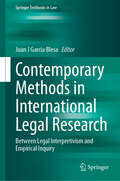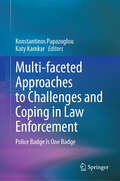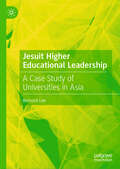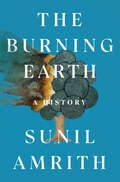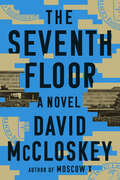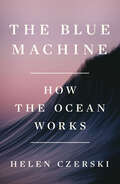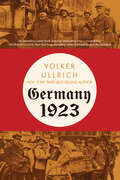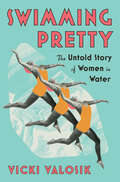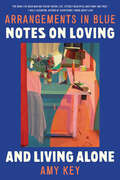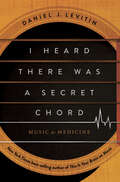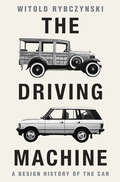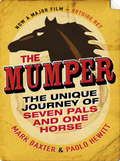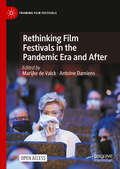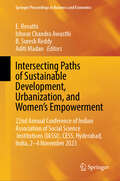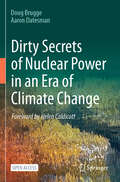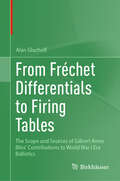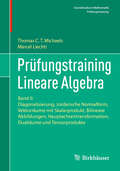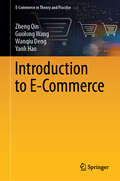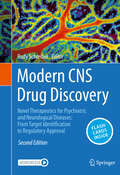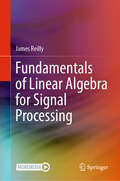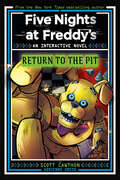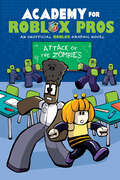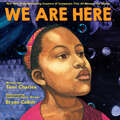- Table View
- List View
Irregularising Human Mobility: EU Migration Policies and the European Commission’s Role (SpringerBriefs in Law)
by Sergio Carrera Davide ColombiThis is an open access book. What is the history and current state of play of EU law and policy covering irregularised human mobility? What has been the role and contributions of the 2019-2024 European Commission as regards EU migration policy? This book investigates how migration policies have been problematised at the EU institutional level, in particular by the European Commission. It critically assesses the assumptions lying behind the Commission’s political priorities, agendas and policy outputs. Through the concept of irregularity assemblages, the book examines how EU policy professionals and bureaucracies in the relevant Commission services problematise their respective mandates/portfolios; how they interact with each other and even compete; and how they frame certain forms of human mobility as being an ‘irregular migration problem’ or not. After retracing key historical developments in the framing of irregularised human mobilities at the EU level, the book identifies six policy approaches in the work and structures of the 2019-2024 European Commission. It finds that a home affairs and criminalisation approach that prioritises a law enforcement understanding of cross-border and intra-EU mobility, and pursuing a Ministry of Interior-like agenda, has prevailed. This approach stands at odds with human dignity and other legitimate public policy approaches, such as those giving priority to employment and social inclusion, non-discrimination, and fundamental rights, where the administrative migration status of the individual is not the entry point. The overriding priority driving EU migration policy has been the expulsion, policing and criminalisation of people framed or categorised as ‘irregular migrants’. The analysis shows how Commission has failed to effectively perform its role as guardian of the Treaties and unequivocally enforce and comply with EU Treaty constitutive values, EU law and Better Regulation commitments in migration policies.
Contemporary Methods in International Legal Research: Between Legal Interpretivism and Empirical Inquiry (Springer Textbooks in Law)
by Juan J Garcia BlesaThis book is a concise practical guide to some of the most relevant ways of thinking and doing international legal research today. It is designed to help students and early career researchers to get acquainted with the theory and practice of a selection of non-doctrinal modes of legal research that include feminist international law, critical international law and TWAIL, complemented with qualitative methods of empirical legal research. The book also encourages a meaningful dialogue with traditional doctrinal styles of legal research. The book’s most innovative aspect is its practical, learner-centred approach, which focuses on the applied learning of the modes of research presented.
Multi-faceted Approaches to Challenges and Coping in Law Enforcement: Police Badge Is One Badge
by Konstantinos Papazoglou Katy KamkarThis volume delves into the wellness, health, and resilience of police officers. Drawing on insights from academics and police leaders, it explores various aspects such as essential training components, prevention strategies, and intervention methods informed by best practices and research. The book aims to pinpoint ways to implement preventive measures across the continuum of care, from primary to tertiary, to enhance the well-being and safety of police officers. Additionally, it addresses organizational and operational stressors to improve occupational health and safety. This resource is well-suited for police leaders, criminology practitioners, mental health professionals, and policymakers.
Jesuit Higher Educational Leadership: A Case Study of Universities in Asia
by Bernard LeeThis book sets out to examine the perceptions of the senior management, faculty members, and administrators of Jesuit leadership in four Asian Jesuit universities. The research question is framed as follows: What are the conceptualisation, collaboration with others, and challenges of Jesuit higher educational leadership? The researcher employed a two-stage research approach to gather the sample. The first stage involved qualitative research, including interviews and expert opinions, while the second stage comprised quantitative research in the form of surveys. This study was conducted across the Philippines, Indonesia, South Korea, and Japan. In total, 30 respondents participated in the interview over the Zoom platform, and 44 completed the online survey. The book made four significant contributions to scholarly literature. First, it conceptualised Jesuit higher educational leadership, which encompassed six features: interpersonal support, community building, selflessness, equality, integrity, and spirituality. Second, it empirically established a scale or a model of Jesuit higher educational leadership. Third, it empirically confirmed that collaboration with others was the mediator between the Jesuit higher educational leadership and the president's performance. Finally, it discovered Jesuit higher educational leaders' challenges, identifying conspicuous similarities and differences between the four universities. The structure of the book is organised into five chapters. Chapter 1 elucidates the background, the gap, the aim, the research questions, the significance of the study, and the organisation of the book. Chapter 2 presents a review of the relevant literature in conceptualising Jesuit higher educational leadership. Chapter 3 explains the study's design, the methodology, findings and analysis of interviews. Chapter 4 presents the methodology, the findings and analysis of the survey. Chapter 5 synthesises all the preceding chapters to respond to the research question posed in the introductory chapter.
The Burning Earth: A History
by Sunil AmrithOne of The New Yorker's "Essential Reads" of 2024 A brilliant, paradigm-shifting global history of how humanity has reshaped the planet, and the planet has shaped human history, over the last 500 years. In this magisterial book, historian Sunil Amrith twins the stories of environment and Empire, of genocide and eco-cide, of an extraordinary expansion of human freedom and its planetary costs. Drawing on an extraordinarily rich diversity of primary sources, he reckons with the ruins of Portuguese silver mining in Peru, British gold mining in South Africa, and oil extraction in Central Asia. He explores the railroads and highways that brought humans to new terrains of battle against each other and against stubborn nature. Amrith’s account of the ways in which the First and Second World Wars involved the massive mobilization not only of men, but of other natural resources from around the globe, provides an essential new way of understanding war as an irreversible reshaping of the planet. So too does this book reveal the reality of migration as consequence of environmental harm. The imperial, globe-spanning pursuit of profit, joined with new forms of energy and new possibilities of freedom from hunger and discomfort, freedom to move and explore, has brought change to every inch of the Earth. Amrith relates in gorgeous prose, and on the largest canvas, a mind-altering epic—vibrant with stories, characters, and vivid images—in which humanity might find the collective wisdom to save itself.
The Seventh Floor: A Novel
by David McCloskeySix CIA officers. Dear friends and cherished enemies. For a quarter century they have stolen other people’s secrets. Now they must steal each other’s. A Russian arrives in Singapore with a secret to sell. When the Russian is killed and Sam Joseph, the CIA officer dispatched for the meet, goes missing, operational chief Artemis Procter is made a scapegoat for the disaster and run out of the service. Months later, Sam appears at Procter’s doorstep with an explosive secret: there is a Russian mole burrowed deep within the highest ranks of the CIA. As Procter and Sam investigate, they arrive at a shortlist of suspects made up of both Procter’s closest friends and fiercest enemies. The hunt requires Procter to dredge up her checkered past in the service of the CIA, placing the pair in the sights of a savvy Russian spymaster who will protect Moscow’s mole in Langley at all costs. What happens when friendships forged by sweat and blood—from the Farm to Afghanistan and the executive “Seventh Floor” of CIA’s Langley headquarters—are put to the ultimate test? What can we truly know about the people we love the most? Taking readers from Langley to Moscow to Paris and beyond, The Seventh Floor explores the nature of friendship in a faithless business, and what it means to love a place that does not love you back.
The Blue Machine: How The Ocean Works
by Helen CzerskiA Financial Times Best Science Book of 2023 “[A] profound, sparkling global ocean voyage.” —Andrew Robinson, Nature A scientist’s exploration of the "ocean engine"—the physics behind the ocean’s systems—and why it matters. All of Earth’s oceans, from the equator to the poles, are a single engine powered by sunlight, driving huge flows of energy, water, life, and raw materials. In The Blue Machine, physicist and oceanographer Helen Czerski illustrates the mechanisms behind this defining feature of our planet, voyaging from the depths of the ocean floor to tropical coral reefs, estuaries that feed into shallow coastal seas, and Arctic ice floes. Through stories of history, culture, and animals, she explains how water temperature, salinity, gravity, and the movement of Earth’s tectonic plates all interact in a complex dance, supporting life at the smallest scale—plankton—and the largest—giant sea turtles, whales, humankind. From the ancient Polynesians who navigated the Pacific by reading the waves, to permanent residents of the deep such as the Greenland shark that can live for hundreds of years, she introduces the messengers, passengers, and voyagers that rely on interlinked systems of vast currents, invisible ocean walls, and underwater waterfalls. Most important, however, Czerski reveals that while the ocean engine has sustained us for thousands of years, today it is faced with urgent threats. By understanding how the ocean works, and its essential role in our global system, we can learn how to protect our blue machine. Timely, elegant, and passionately argued, The Blue Machine presents a fresh perspective on what it means to be a citizen of an ocean planet.
Germany 1923: Hyperinflation, Hitler's Putsch, And Democracy In Crisis
by Volker UllrichFrom the New York Times best-selling historian comes a gripping account of the crisis of the Weimar Republic, when hyperinflation and political upheaval threatened to unravel a new experiment in democracy. As the great Austrian writer Stefan Zweig confided in his autobiography, written in exile, “I have a pretty thorough knowledge of history, but never, to my recollection, has it produced such madness in such gigantic proportions.” He was referring to the situation in Germany in 1923. It was a “year of lunacy,” defined by hyperinflation, a political system on the verge of collapse, and separatist movements that threatened Germany’s territorial integrity. Most significantly, Adolf Hitler launched his infamous Beer Hall Putsch in Munich—a failed coup that nonetheless drew international attention and demonstrated the Nazis’ ruthless determination to seize power. In Germany 1923, award-winning historian Volker Ullrich draws on letters, memoirs, newspaper articles, and other sources from the time to present a captivating new history of those explosive twelve months. The crisis began when the French invaded the Ruhr Valley in January to force Germany to pay the reparations it owed under the Treaty of Versailles, which had ended the Great War. For years, German leaders had embraced inflationary policies to finance the costs of defeat, and, as Ullrich demonstrates, the invasion utterly destroyed the value of the German mark. Before the war, the exchange rate was 4.2 marks to the dollar. By November 20, 1923, a dollar was worth an incomprehensible 4.2 trillion marks, and a loaf of bread cost 200 billion. Facing the abyss, many ordinary Germans called for a national messiah. Among the figures to vie for that role was Hitler, a thirty-four-year-old veteran who possessed a uniquely malevolent personal magnetism. Although the Nazi coup in November was put down and Hitler arrested, the putsch showed just how tenuous the first German democracy, the Weimar Republic, was at its core. As Ullrich’s panoramic narrative reveals, other Germans responded to the successive crises by launching a cultural revolution: 1923 witnessed the emergence of a multitude of new movements, from Dada to Bauhaus, and of such iconoclasts as Bertolt Brecht, George Grosz, and Franz Kafka. Yet most observers were amazed that the Weimar Republic was able to survive, and the more astute realized that the feral undercurrents unleashed could lead to much worse. Publishing a century after that fateful year, Germany 1923 is a riveting chronicle of one of the most challenging times any modern democracy has faced, one with haunting parallels to our own political moment.
Swimming Pretty: The Untold Story of Women in Water
by Vicki ValosikA groundbreaking history of how women found synchronicity—and power—in water. “If you’re not strong enough to swim fast, you’re probably not strong enough to swim ‘pretty,’” said a young Esther Williams to theater impresario Billy Rose. Since the nineteenth century, tensions between beauty and strength, aesthetics and athleticism have both impeded and propelled the careers of female swimmers—none more so than synchronized swimmers, for whom Williams is often considered godmother. In this revelatory history, Vicki Valosik traces a century of aquatic performance, from vaudeville to the Olympic arena, and brings to life the colorful cast of characters whose “pretty swimming” not only laid the groundwork for an altogether new sport but forever changed women’s relationships with water. Williams, who became a Hollywood sensation for her splashy “aquamusicals,” was just one in a long, bedazzled line of swimmers who began their careers as athletes but found greater opportunity, and often social acceptance, in the world of show business. Early starlets like Lurline the Water Queen performed “scientific” swimming, a set of moves previously only practiced by men—including Benjamin Franklin—that focused on form and exhibited mastery in the water. Demonstrating their fancy feats in aquariums and water tanks rolled onto music hall stages, these women stunned Victorian audiences with their physical dexterity and defied society’s rigid expectations of what was proper and possible for their sex. Far more than bathing beauties, they ushered in sensible swimwear and influenced lifesaving and physical education programs, helping to drop national drowning rates and paving the way for new generations of female athletes. When a Chicago physical educator matched their aquatic movements to music in the 1920s, young girls flocked to take part in “synchronized swimming.” But despite overwhelming love from audiences and the Olympic ambitions of its practitioners, “synchro” was long perceived as little more than entertaining pageantry, and its athletes would face a battle against the current to earn a spot at the highest echelons of sport. Now, on the fortieth anniversary of synchronized swimming’s elevation to Olympic status, Swimming Pretty honors its incredible history of grit, glamor, and sheer athleticism.
Arrangements in Blue: Notes on Loving and Living Alone
by Amy Key"[Arrangements in Blue] reflects on a life spent as a single woman and how that affects friendships, freedom, domesticity, family, sexuality, the psyche, the self. It observes things about being alone that I have never seen or heard articulated before.... beautiful, effortless.... I haven’t been so obsessed with a book in a long time." —Dolly Alderton “The poet Amy Key’s first book might be the most hyped memoir of 2023 (or at least a close second to Spare)… This raw, gorgeous, pulsing memoir is…the harbinger of a real talent.” —Laura Hackett, Sunday Times [UK] Amy Key—a writer “of rare and strange magic” (Guardian)—probes the art of living without romance in this soul-stirring debut. When British poet Amy Key was growing up, she envisioned a life shaped by love—and Joni Mitchell’s album Blue was her inspiration. “Blue became part of my language of intimacy,” she writes, recalling the dozens of times she played the record as a teen, “an intimacy of disclosure, vulnerability, unadorned feeling that I thought I’d eventually share with a romantic other.” As the years ticked by, she held on to this very specific idea of romance like a bottle of wine saved for a special occasion. But what happens when the romance we are all told will give life meaning never presents itself? Now single in her forties, Key explores the sweeping scales of romantic feeling as she has encountered them, using the album Blue as an expressive anchor: from the low notes of loss and unfulfilled desire—punctuated by sharp, discordant feelings of jealousy and regret—to the deep harmony of friendship, and the crescendos of sexual attraction and self-realization. Finding solace in Mitchell’s songs, Key plumbs Blue’s track list for themes that resonate with her heart’s seasons. Listening to the song “California,” she explores the mixed emotions that come with traveling alone in a world built for couples; she juxtaposes the lonely lyrics of “My Old Man” with the pleasurable art of curating a perfect apartment for one; and with the utmost tenderness, she parses out her decision to not have children with the eloquent “Little Green.” Mapping the evolution of her early conceptions of love through her adulthood, Key offers a tender and nakedly candid celebration of the many forms of intimacy that often go unnoticed. An essential work for both the single and the partnered, Arrangements in Blue is a bold manual for building a life on your own terms.
I Heard There Was a Secret Chord: Music as Medicine
by Daniel J. LevitinNATIONAL BESTSELLER One of Smithsonian's 10 Best Science Books of 2024 Neuroscientist and New York Times best-selling author of This Is Your Brain on Music Daniel J. Levitin reveals the deep connections between music and healing. Music is one of humanity’s oldest medicines. From the Far East to the Ottoman Empire, Europe to Africa and the pre-colonial Americas, many cultures have developed their own rich traditions for using sound and rhythm to ease suffering, promote healing, and calm the mind. In his latest work, neuroscientist and New York Times best-selling author Daniel J. Levitin (This Is Your Brain on Music) explores the curative powers of music, showing us how and why it is one of the most potent therapies today. He brings together, for the first time, the results of numerous studies on music and the brain, demonstrating how music can contribute to the treatment of a host of ailments, from neurodegenerative diseases such as Parkinson’s and Alzheimer’s, to cognitive injury, depression, and pain. Levitin is not your typical scientist—he is also an award-winning musician and composer, and through lively interviews with some of today’s most celebrated musicians, from Sting to Kent Nagano and Mari Kodama, he shares their observations as to why music might be an effective therapy, in addition to plumbing scientific case studies, music theory, and music history. The result is a work of dazzling ideas, cutting-edge research, and jubilant celebration. I Heard There Was a Secret Chord highlights the critical role music has played in human biology, illuminating the neuroscience of music and its profound benefits for those both young and old.
The Driving Machine: A Design History of the Car
by Witold RybczynskiThe renowned design writer on the extraordinary history of car design. In this lively and entertaining work, Witold Rybczynski—hailed as “one of the best writers on design working today” by Publishers Weekly—tells the story of the most distinctive cars in history and the artists, engineers, dreamers, and gearheads who created them. Delving into more than 170 years of ingenuity in design, technology, and engineering, he takes us from Carl Benz’s three-wheel motorcar in 1855 to the present-day shift to electric cars. Along the way, he looks at the emergence of mass production with Henry Ford’s Model T; the Golden Age of American car design and the rise of car culture; postwar European subcompacts typified by the Mini Cooper; and the long tradition of the streamlined and elegant sports car. Rybczynski explores how cars have been reflections of national character (the charming Italian Fiat Cinquecento), icons of a subculture (the VW bus for American hippies), and even emblems of an era (the practical Chrysler minivan). He explains key developments in automotive technology, including the electric starter, rack-and-pinion steering, and disc brakes, bringing to light how the modern automobile is the result of more than a century of trial and error. And he weaves in charming accounts of the many cars he’s owned and driven, starting with his first—the iconic Volkswagen Beetle. The Driving Machine is a breezy and fascinating history of design, illustrated with the author’s delightful drawings.
The Mumper
by Paolo Hewitt Mark BaxterSeven drinking buddies decide to buy a racehorse and embark on the journey of a lifetime in the book that inspired the film Outside Bet.It's 1985 - Thatcher is in power, Sade is on the radio and the print workers have gone on strike. A motley rabble of seven firm friends: Thimble, Gudger, O'Sh, Fred the Shoe, Dave, Alfie and Bax meet every Sunday in their favourite South London boozer for banter of the highest order and a lot of taking the mick. Then, out of the blue, one of their number receives some news which knocks him and his merry band for six. Reeling from this shock and confused about how to deal with it, the boys meet and rally in standard fashion, in the Dutchman with a few light ales and an aim to set the world to rights. One day an unknown character approaches the crew and asks them a most intriguing question...'Does anyone here want to buy a racehorse?!'From that simple but surreal question unfolds the story of seven likely lads who embark on a unique journey in the name of their mate, and what happens when they just decide to go the whole bifta.
Measles and Related Morbilliviruses: Methods and Protocols (Methods in Molecular Biology #2808)
by Dzwokai Z. Ma Christian K. PfallerThis volume covers the latest protocols used to study the molecular biology of morbilliviruses, including cell entry, replication, and virus-host interactions. The chapters in this book also cover methods for studying morbillivirus infection through the use of novel tissue culture and in vivo models; analyzing the biological implications of infection by using primary tissues isolated from infected animals; and exploring diagnostic tools to evaluate humoral immunity against human-pathogenic measles virus (MeV). Written in the highly successful Methods in Molecular Biology series format, chapters include introductions to their respective topics, lists of the necessary materials and reagents, step-by-step, readily reproducible laboratory protocols, and tips on troubleshooting and avoiding known pitfalls.Cutting-edge and comprehensive, Measles and Related Morbilliviruses: Methods and Protocols is a valuable resource for researchers studying MeV,and will be useful to researchers studying other members of Paramyxoviridae and Mononegavirales.
Rethinking Film Festivals in the Pandemic Era and After (Framing Film Festivals)
by Marijke De Valck Antoine DamiensThis is an open access book. This edited collection aims to document the effects of Covid-19 on film festivals and to theorize film festivals in the age of social distancing. To some extent, this crisis begs us to consider what happens when festivals can’t happen; while films have found new (temporary) channels of distribution (most often in the forms of digital releases), the festival format appears particularly vulnerable in pandemic times. Imperfect measures, such as the move to a digital format, cannot recapture the communal experience at the very core of festivals. Given the global nature of the pandemic and the diversity of the festival phenomenon, this book features a wide range of case studies and analytical frameworks. With contributors including established scholars and frontline festival workers, the book is conceived as both a theoretical endeavour and a practical exploration of festival organizing in pandemic times.
Intersecting Paths of Sustainable Development, Urbanization, and Women’s Empowerment: 22nd Annual Conference of Indian Association of Social Science Institutions (IASSI), CESS, Hyderabad, India, 2–4 November 2023 (Springer Proceedings in Business and Economics)
by Ishwar Chandra Awasthi E. Revathi B. Suresh Reddy Aditi MadanThis volume is a collection of 14 conference papers discussing India's development story around the three themes of sustainable development goals (SDGs), agricultural productivity and sustainability, and climate change - mitigation and adaptation. The contributions take cognizance of India's increasing growth rate over the past 10 years or so, leading to reduced extreme poverty; virtual elimination of absolute poverty in urban areas; and visible improvements in education, health, sanitation, infrastructure, and energy sectors. The volume unravels how despite the high and sustained economic growth rate achieved by India in the recent past, employment generation has been far from satisfactory. It looks at emerging concerns including rising inequalities, child under-nutrition, and environmental challenges, including the rising frequency of climate change-induced extreme weather events that threaten the progress towards sustainable development. The book discusses pressing societal challenges such as income inequality, climate change, and inclusive development. It presents research on social challenges exacerbated by globalization, emphasizing the need for resilience in diverse geographies as presented by India. The empirical research presented by the book provides pointers to the policymakers on the core issues of the conference.
Dirty Secrets of Nuclear Power in an Era of Climate Change
by Doug Brugge Aaron DatesmanThis open access book provides a review of the serious limitations and drawbacks to nuclear power, and clearly conveys why nuclear power is a less than desirable option in terms of addressing climate change. It uses accessible and engaging language to help bring an understanding of the issues with nuclear power to a broader sector of the public, with the intention of appealing to non-scientists seeking knowledge on the disadvantages of nuclear power as a solution for climate change. The argument is made that while superficially appealing, nuclear power is too costly, fragile, and slow to implement, compared to alternative options such as wind and solar. “As this book shows, to nowadays hold on to Nuclear Energy, a risky and extremely expensive method of create power, just does not make sense any longer.” -- Prof. (em.) Andreas Nidecker, MD, retired academic radiologist, Basel, Switzerland “Datesman and Brugge present evidence that nuclear power is an insecure and unsecureable technology, inherently incompatible with humanity and democracy; it fuels nuclear weapons technology and possession; choosing it would damage our chances at mitigating the climate crisis.” -- Cindy Folkers, MS, Radiation & Health Specialist, Beyond Nuclear “Although the government, industrial, and scientific nexus say it is safe.…I can only think of one word in Navajo "Ina'adlo'" meaning manipulation by the power that be to say it is safe. My Navajo people are dying from the uranium exposure on their health and environment. Great account of information on studies that have taken place around the world to say uranium is not good.” – Esther Yazzie, Navajo Interpreter and knowledge holder on Navajo issues. “At a time when there is a call to triple the growth of nuclear power, Datesman and Brugge provide a timely and thorough examination of the dark-side of “romancing” the atom. With solid technical astuteness, they cover a wide field littered with unsolved and dangerous problems ranging from the poisoning of people and the environment to the failed economics, to the spread of nuclear weapons ….they point out how science and public trust have been corrupted by the lure of unfettered nuclear growth.” –Robert Alvarez, Associate Fellow at the Institute for Policy Studies in Washington, D.C.
From Frechet Differentials to Firing Tables: The Scope and Sources of Gilbert Ames Bliss' Contributions to World War I Era Ballistics
by Alan GluchoffThis monograph explores the history of the contribution to ballistics by the American mathematician Gilbert Ames Bliss during World War I. Drawing on the then-evolving calculus of variations, Bliss pioneered a novel technique for solving the problem of differential variations in ballistic trajectory. Called Bliss’ adjoint method, this technique was both hailed and criticized at the time: it was seen as both a triumphant application of pure mathematics to an applied problem and as a complex intrusion of higher mathematics into the jobs of military personnel not particularly interested in these matters. Although he received much praise immediately after the War, the details of Bliss’ work, its furthering of pure mathematical thought, and its absorption into mainstream ballistic work and instruction have never been adequately examined. Gluchoff explores the mathematics of Bliss’ work and the strands from which his technique was developed. He then documents the efforts to make the adjoint method accessible to military officers and the conflicts that emerged as a result both between mathematicians and officers and among mathematicians themselves. The eventual absorption of the adjoint method into range firing table construction is considered by looking at later technical books which incorporate it, and, finally, its influence on the ongoing development of functional calculus is detailed. From Frechet Differentials to Firing Tables will appeal to historians of mathematics, physics, engineering, and warfare, as well as current researchers, professors, and students in these areas.
Prüfungstraining Lineare Algebra: Band II: Diagonalisierung, Jordansche Normalform, Vektorräume mit Skalarprodukt, Bilineare Abbildungen, Hauptachsentransformation, Dualräume und Tensorprodukte (Grundstudium Mathematik)
by Marcel Liechti Thomas MichaelsMit über 600 Aufgaben mit ausführlichem Lösungsweg sowie 150 Multiple-Choice-Testfragen und 4 Musterprüfungen. Dieses Trainingsbuch ist das ideale Begleitbuch für alle Bachelorstudierenden im Fach Mathematik und für die Grundlagenvorlesungen in ingenieur-, natur- und wirtschaftswissenschaftlichen Studiengängen. Es ist speziell geeignet zur Vorbereitung auf Assessmentprüfungen und Basisprüfungen im Themenbereich Lineare Algebra. In Band II werden die folgenden zentralen Themen behandelt: Diagonalisierung und Trigonalisierung Jordansche Normalform Vektorräume mit Skalarprodukt Bilineare Abbildungen und Hauptachsentransformation Dualräume und Tensorprodukte Der Stoff wird nicht in der klassischen Lehrbuch-Struktur von Definition, Satz und Beweis präsentiert, sondern kann anhand von mehr als 600 Aufgaben mit unterschiedlichen Schwierigkeitsgraden erlernt und trainiert werden. Alle Übungen werden Schritt für Schritt durchgerechnet, der Lösungsweg wird verständlich erklärt und es werden viele Rechentipps gezeigt. Dabei wird ein breites Spektrum von typischen (Prüfungs-) Aufgabentypen berücksichtigt. Am Ende geben 150 Multiple-Choice Testfragen und 4 konkrete Musterprüfungen, mit ausführlichen Lösungen, dem Leser die Möglichkeit sein Wissen final zu testen und dadurch den Stoff zu festigen.
Introduction to E-Commerce (E-Commerce in Theory and Practice)
by Zheng Qin Guolong Wang Wanqiu Deng Yanli HaoThis book brings together the new trends, new knowledge, new methods and new tools in the development of e-commerce in China and global and appropriately expounds the basic concepts and cultural concepts of e-commerce from the perspective of e-commerce basic knowledge and e-commerce culture. The key technology involved including e-commerce support, payment, and security is introduced. This book highlights the practical application of the applied psychology of e-commerce in business activities and expounds the system structure, transaction mode, and decision-making strategy paradigm of e-commerce with typical examples. This book helps readers to understand the basic concepts, the latest knowledge and the way of e-commerce development. This book elaborates the theory, specific tools, methods, and practical experience, which can be used as a textbook or professional book for e-commerce courses and also a reference book for interested readers.
Modern CNS Drug Discovery: Novel Therapeutics for Psychiatric and Neurological Diseases: From Target Identification to Regulatory Approval
by Rudy SchreiberThis new edition is a comprehensive guide to the intricate world of drug discovery and development. It provides readers with an update on basic and novel concepts, approaches and technologies that are used in the discovery and development of new therapeutics for diseases of the central nervous system (CNS). A major aim is to support the education of professionals and specialists in the biomedical neurosciences that will become the innovators, entrepreneurs, and leaders of the future. The educational focus is now enhanced by the inclusion of over 150 study questions available in the free Springer Nature Flashcard App, which makes this a unique book in its field. Divided into five sections, the book starts by introducing concepts and ideas to inspire the next generation of life scientists pursuing careers in drug discovery for CNS diseases. In the following section, key strategies and methods for identifying and testing novel drug targets are described. New chapters on important topics have been added, that is, the blood brain barrier, mass spectrometry, biased signaling and the exposome. The third section highlights strategies and technologies in translational CNS drug discovery and looks at safety and drug metabolism assessment, imaging techniques and functional testing to investigate drug treatment outcomes. The chapters in the fourth section address the emergence of transdiagnostic approaches as exemplified by the Research Domain Criteria initiative and non-invasive brain stimulation techniques. Finally, the book concludes with the late stages of drug development, such as the planning and performance of clinical trials, and regulatory approval. Written by experts from academia and industry, the book covers important fundamentals and best practices as well as current developments in neurotherapeutic research. It offers in-depth insights into the world of drug development and is essential reading for young scientists who are interested in translational research and want to prepare for an academic or industry career in CNS drug discovery.
Fundamentals of Linear Algebra for Signal Processing
by James ReillySignal processing is ubiquitous in many fields of science and engineering. This textbook is tailored specifically for graduate students and presents linear algebra, which is requisite knowledge in these fields, in a form explicitly targeted to signal processing and related disciplines. Written by an experienced author with over 35 years of expertise in signal processing research and teaching, this book provides the necessary foundation in a focused and accessible manner, offering a practical approach to linear algebra without sacrificing rigor. Emphasis is placed on a deeper conceptualization of material specific to signal processing so students may more readily adapt this knowledge to actual problems in the field. Since other emerging areas, such as machine learning, are closely related to signal processing, the book also provides the necessary background in this discipline. The book includes many examples and problems relevant to signal processing, offering explanations and insights that are difficult to find elsewhere. Fundamentals of Linear Algebra for Signal Processing will allow students to master the essential knowledge of linear algebra for signal processing. It is also an essential guide for researchers and practitioners in biomedical, electrical, chemical engineering, and related disciplines.
Five Nights at Freddy's: Return to the Pit (Five Nights At Freddy's)
by Adrienne Kress Scott CawthonReturn to Freddy Fazbear's Pizza in this interactive novel in which YOU decide what happens!Dive into an interactive retelling of one of the most popular FNAF stories, and the basis for the hit video game "Into the Pit"! You the reader are Oswald, and after using the ball pit at Jeff's Pizza to travel back in time to 1985, you've brought a sadistic animatronic back into the present. Can you escape? Or will it be game over for you and your friends? With over 25 different possible endings and two difficulty settings, this one-of-a-kind, innovative novel is a uniquely entertaining experience for any Freddy fan.
Attack of the Zombies (Academy for Roblox Pros Graphic Novel #1)
by Louis SheaDo you have what it takes to be a student at the academy for Roblox pros? Introducing the first book in an unofficial Roblox graphic novel series, Academy for Roblox Pros! Mitch and his friends thought that they were having an average day at school. Their principal, Principal Borelox, was being awful as usual, and Roger and his cronies were getting on their nerves. But when Mitch accidentally spills his drink on his computer in the tech lab, something miraculous happens. A door appears out of nowhere with the symbol of their favorite video game, Roblox. Well, Mitch and his buddies just have to check it out!Stepping through the door, the kids are immediately transported into Roblox Academy, a blocky world where they are all avatars of themselves. Can the kids get to the bottom of this digital world ... or will the mysterious villain, Mr. Warlock, turn them all into zombies!? Read and find out in this illustrated unofficial Roblox graphic novel series!
We Are Here (An All Because You Matter Book) (Digital Read Along)
by Tami CharlesAn empowering follow-up to New York Times bestselling picture book All Because You Matter that celebrates the rich history of Black and brown men and women throughout history with soaring language and stunning illustration.Lyrical, affirmational, and bursting with love, We Are Here is a poignant story about Black and brown heritage and community. Full of assurance, tenderness, and triumph, this much-anticipated follow-up to the New York Times bestselling picture book All Because You Matter offers an equally inspirational and arresting ode to all of the Black women and men throughout history who have made momentous contributions from the beginning of time.Tami Charles shares the beauty and excellence in the history of the Black community, assuring Black and brown children of the extraordinary legacy from which they come. Charles's powerful and empowering text is accompanied with illustrations by renowned artist Bryan Collier, a four-time Caldecott Honor recipient and a nine-time Coretta Scott King Award winner or honoree. We Are Here celebrates readers with pride, joy, and love, reminding them of their roots, inviting readers to imagine a future that shines ever bright, and strengthening them for their triumphant days to come!
